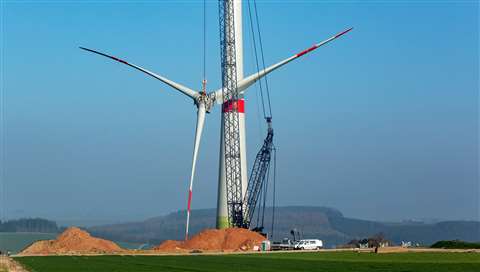5 things driving an acceleration in wind energy construction projects
05 April 2023
 A crane from Kranlogistik Lausitz working on a wind farm installation for Enercon in Germany (Image: Ingo Bartussek via AdobeStock - stock.adobe.com)
A crane from Kranlogistik Lausitz working on a wind farm installation for Enercon in Germany (Image: Ingo Bartussek via AdobeStock - stock.adobe.com)
The accelerating construction of new onshore and offshore wind farms will create 680 GW of new capacity around the world by 2027.
The wind industry is forecast to install 136 GW per year, reaching a compound annual growth rate of 15%, according to a new report from the Global Wind Energy Council.
The news comes as a joint venture between EDF Renewables and Maple Power won a design, build, operate and decommission contract to build a 1GW capacity offshore windfarm off the coast of Normandy in France last week.
The predicted upsurge in construction of wind farms globally comes after a sluggish year in 2022, when higher inflation and logistics costs coupled with inefficient permitting and licensing rules slowed installations to 77.6 GW for the year.
But the report predicted that the wind market would bounce back in 2023, exceeding 100 GW for the first time.
It attributed the upswing in wind farm construction to five factors. They are:
- A renewed urgency in Europe to replace fossil fuels with renewables, amid the war in Ukraine. Europe’s renewed urgency to replace fossil fuels with renewables to achieve energy security in the aftermath of the Russian invasion of Ukraine. In order to reach the objectives of Europe’s new energy security strategy, it needs to build an average of 30 GW of new wind energy capacity to 2030.
- The Inflation Reduction Act (IRA) is expected to drive a strong uplift in wind projects in the US over the next 10 years. Since the IRA was signed into law, the renewable energy industry has announced six new wind power manufacturing facilities. Meanwhile, the American Clean Power Association estimates the IRA will deliver upwards of 550 GW of new clean power through to the end of the decade.
- China has committed to renewables in its energy mix, aiming for renewable energy to contribute more than 80% of total new electricity consumption by the end of the 14th Five-Year Plan (2021-2025). The country achieved record additions of 68.8 GW of grid-connected onshore wind in 2020 and 16.9 GW of offshore installations by 2021 by phasing out renewable subsidies.
- Governments waking up to the opportunities that offshore wind presents. The world needs 2,000 GW of offshore wind by 2050 to reach net zero, which means adding 35 GW of offshore wind annualy in the coming decade, according to the GWEC. It noted that only China has so far shown the ability to deliver at this scale and speed. But at least 16 governments have set or increased their offshore wind targets since GWEC’s 2022 report. In September 2022, ministers from the North Seas Energy Cooperation (NSEC) agreed to reach at least 260 GW off offshore wind capacity by 2050. China is targeting 1,000 GW by 2050, while South Korea is aiming for 14.3 GW by 2030.
- Strong growth in large emerging markets both onshore and offshore from the middle of this decade. Among the markets the GWEC identified as ones to watch was Brazil, whose onshore wind capacity surpassed 24 GW in 2022. Brazil’s state-owned energy company Petrobas has announced that it will re-enter the renewables sector under Brazil’s new president Luiz Inácio ‘Lula’ da Silva. Petrobas is already considering developing seven new offshore projects with a total capacity of 14.5 GW. Meanwhile, India has a target to achieve a cumulative 140 GW of wind power capacity by 2030.
Ben Blackwell, CEO of the GWEC, said that while wind energy has taken 40 years to get to 1 TW of capacity around the world, it will take until the end of 2030 to get to 2 TW.
He said, “2023 will mark the start of a decisive turnaround. Governments of all the major industrialised nations have enacted policies that will result in a significant acceleration of deployment.
But he warned that there is an “urgent need” to ramp up investment in the wind energy supply chain around the work.
The GWEC forecast supply bottlenecks for turbines and components as soon as 2025 amid the heightened demand.
Blackwell added, “GWEC expects a sustained surge in growth over the coming decade and beyond. But in order to ensure implementation, policymakers need to act decisively to fix market and regulatory barriers to allow investment to flow into new factories to avoid future bottlenecks.
“In addition, we need much more active global collaboration to enhance and de-risk the supply of critical raw materials in order to ensure that the green economic revolution had the inputs it needs in this crucial period.”
STAY CONNECTED



Receive the information you need when you need it through our world-leading magazines, newsletters and daily briefings.
CONNECT WITH THE TEAM








